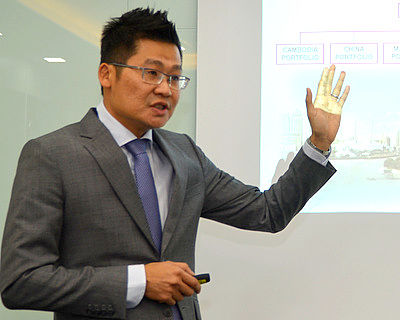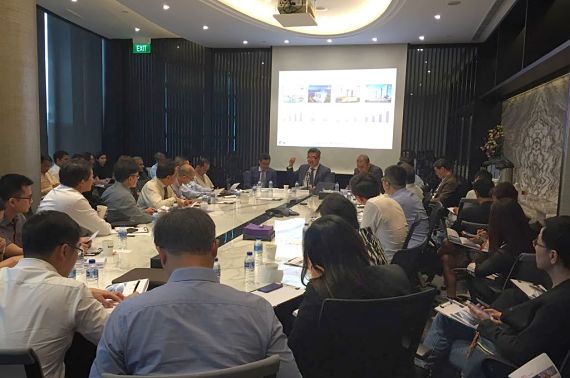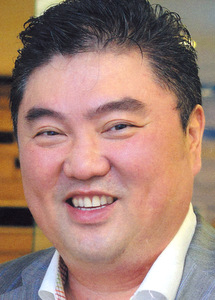|
Investors at Oxley's FY2017 results briefing had a burning question, and they received what may be said to be an anti-climax answer. |
OK, so it's an investment, perhaps not unlike the stakes that Oxley has taken in its Aussie and UK partners: Pindan Group and Galliard Group, respectively.
Here are six other takeaways from the briefing:
1. Asset-light strategy: It's not been highlighted before but, it is clear now, Oxley generally does not buy land for its overseas projects but instead enters into various "capital efficient" deals with the local authorities and land owners.
Mr Ching said: "We didn’t pay for the land in our development projects in Cambodia, Batam, Penang and Dublin."
Thus, Oxley mitigates its business risks, saves on financing costs, and enjoys strong cashflows when it launches the projects.
2. Recurring income: Oxley has grown, and continues to grow, its investment portfolio and, especially, its hospitality assets. It is now projecting significant recurring income in the years ahead.
The hospitality segment -- chiefly, hotels in Singapore, KL and Cambodia -- will be the main contributors (For details, see FY17 presentation).
|
Recurring revenue projected to become substantial |
||||
|
(S$’m) |
FY2018 |
FY2019 |
FY2020 |
FY2021 |
|
Hospitality |
60.3 |
83.8 |
114.8 |
153.5 |
|
Property investments |
12.4 |
13.4 |
13.5 |
13.6 |
|
Total |
72.7 |
97.2 |
128.3 |
167.1 |
3. Singapore projects: Oxley raised $500 million in recent months and successfully bid for 5 sites in double-quick time.
This is the largest landbank in Singapore currently. It has 3,000 units planned for launch in the next 12 months with a gross development value of $3.32 billion.
 Deputy CEO Eric Low. NextInsight file photoOxley deputy CEO Eric Low said: "We have been very busy and working day and night, trying to push for the projects to be launched as early as possible because we think the market is good."
Deputy CEO Eric Low. NextInsight file photoOxley deputy CEO Eric Low said: "We have been very busy and working day and night, trying to push for the projects to be launched as early as possible because we think the market is good."
Oxley has been fortunate in the timing of its purchase of its landbank.
An example is the Oxley-led consortium which bought, en-bloc, Serangoon Ville, a former HUDC estate in Serangoon North, in July 2017.
Its purchase price: $835 psf per plot ratio.
Shortly later, a Wing Tai-Keppel Land joint venture successfully bid for a piece of land, also in Serangoon North, at $964.50 psf per plot ratio.
"For en-bloc land, we can adopt conventional construction methods but for government land sales, you have to use PBVC (Prefabricated Volumetric Construction) which easily costs $40-50 psf more," said Mr Low. "All in, our purchase is about $200 psf cheaper than Wing Tai-Keppel."
He expects that selling prices at Oxley's Serangoon Ville will be supported by Wing Tai-Keppel's higher pricing.
4. Royal Wharf in London: The drop-out rate has been minimal, contrary to some investors' fears that a significant number of buyers would not complete their purchases of Royal Wharf in the wake of Brexit.
Oxley has handed over 335 units at Royal Wharf and the dropout rate was a trickle: Less than 1%.
The project has more than 3,000 homes, 90% of which has been sold.
"To date, Royal Wharf is providing us the best cash flow that we can ever have," said Mr Low.
|
Stock price |
57 c |
|
52-week range |
38 – 61.5 c |
|
PE (ttm) |
7.7 |
|
Market cap |
S$1.7 b |
|
Shares outstanding |
2.9 billion |
|
Dividend |
1.23% |
|
Year-to-date return |
33% |
|
Source: Bloomberg |
|
5. Malaysia: The two largest projects are the KLCC, a mixed development opposite the Petronas Twin Towers, and a residential project in Penang.
Their respective gross development values are estimated to be S$971 million and S$703 million.
"Our KL project is in a prime location and we assure you that before the end of this year we will launch it. Everything is ready."
As for the proposed Penang project, Oxley does not own the land but has the right to develop it under a JV structure.
Given the challenging property market, Oxley is looking to improved market conditions before embarking on it.
6. Dublin: Next month, Oxley will put up the first block of its Dublin Landings project for sale.
"We think that a lot of pension funds will be looking at it. At 4.5% yield, we are talking about €1,001 per sq ft. Construction cost was about €300 psf. So, there will be another windfall for us," said Mr Low.
"A lot of cash will be coming back because we have funded the construction ourselves, taking only a small loan."
|
|









